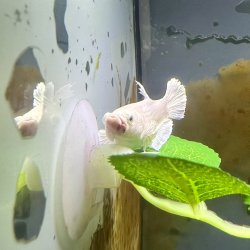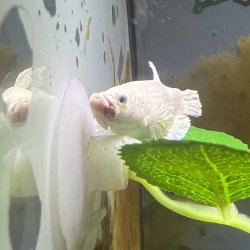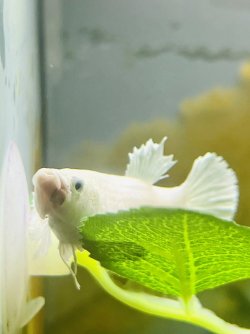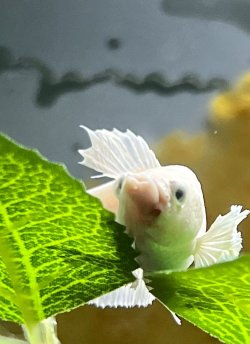jayveechun
New Member
Hi
Needing your inputs on a female plakat white betta I have.
She has been acting odd lately, and something seems to be growing on her lip the past 3 weeks.
It seems like a pimple or some form of abcess. See photos below.




It has had affected her gusto of feeding, though she still eats daily. I will need to sprinkle MIcropellets above her for her to eat vs her usual going after food.
I have tried the following
1) Full course (4 days) of API EM Erthromycin. No change. This is for gran positive bacterial
2) Full course (5 days) of Seachem Kanaplex. No change. This is for gram negative bacteria and some fungus.
3) Currently on day 8 of Seachem Paraguard. No change. THis is for external flukes and such.
Im not sure what else to do. Im thinking of using Metroplex if Paraguard does nothing after day 14...
Parameters are as follows
Tank: 5 gallons
Temp: 80-84F (I live in the tropics)
Ammonia: 0ppm
NItrite: 0 ppm
NItrate: maxes at 10ppm before water change (weekly)
I also dose Seachem Stability and Prime daily JUST IN CASE the medication disrupt the biofilter but my ammonia is always 0ppm anyway. Dont worry, I separate the Prime and the Paraguard by 12 hours since both are reducing agents.
Has anyone experienced this with their betta?
Needing your inputs on a female plakat white betta I have.
She has been acting odd lately, and something seems to be growing on her lip the past 3 weeks.
It seems like a pimple or some form of abcess. See photos below.




It has had affected her gusto of feeding, though she still eats daily. I will need to sprinkle MIcropellets above her for her to eat vs her usual going after food.
I have tried the following
1) Full course (4 days) of API EM Erthromycin. No change. This is for gran positive bacterial
2) Full course (5 days) of Seachem Kanaplex. No change. This is for gram negative bacteria and some fungus.
3) Currently on day 8 of Seachem Paraguard. No change. THis is for external flukes and such.
Im not sure what else to do. Im thinking of using Metroplex if Paraguard does nothing after day 14...
Parameters are as follows
Tank: 5 gallons
Temp: 80-84F (I live in the tropics)
Ammonia: 0ppm
NItrite: 0 ppm
NItrate: maxes at 10ppm before water change (weekly)
I also dose Seachem Stability and Prime daily JUST IN CASE the medication disrupt the biofilter but my ammonia is always 0ppm anyway. Dont worry, I separate the Prime and the Paraguard by 12 hours since both are reducing agents.
Has anyone experienced this with their betta?


